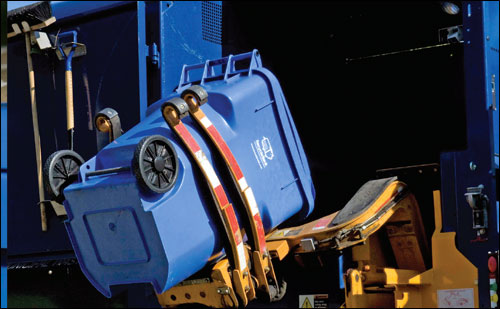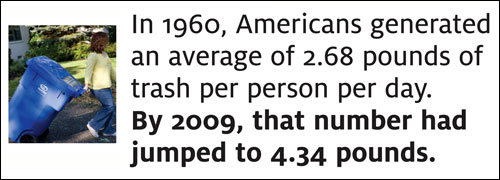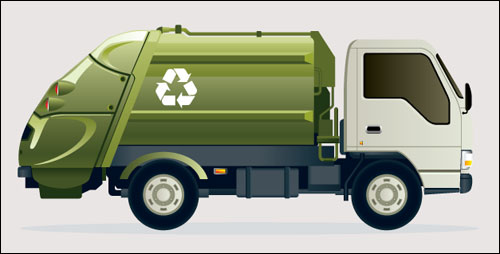Hattiesburg, the fourth largest city in Mississippi, had a serious problem with garbage. The city did not provide trash receptacles, so some of its 50,000 residents placed garbage bags on curbs, where wild animals frequently rifled through them and scattered debris in the streets. Sanitation workers were often injured by sharp objects or passing vehicles, or from heaving the garbage into the trucks, which led to numerous Workers’ Compensation claims. And many times, the trash went uncollected altogether.
“We were having lots of calls from residents complaining that their trash wasn’t being picked up, or that their cans were damaged or missing,” says Russell Davis, Hattiesburg’s director of public services. “We wanted to know what garbage was being picked up and when. We had drivers returning from their routes by 11 a.m., saying they were done. We knew that couldn’t have been right.”

For nearly 10 years, the city had considered automating the manual collection system, but was deterred by the high cost. That changed when city officials learned about the benefits of RFID-based systems. In August 2010, the city’s sanitation department converted to a $3.5 million automated garbage-collection system, from RFID systems integrator Concept2 Solutions. The RFID solution includes more than 22,000 RFID-tagged collection carts from Otto Environmental Systems—each household receives a green can for household garbage and a brown one for yard trash—and 12 new trucks equipped with RFID readers, from Motorola, and mechanical arms that lift and empty the carts.
Each time a cart is tipped into the truck, the reader captures the tag’s identification number, and software onboard the vehicle associates it with the GPS coordinates of the truck’s location, as well as the date and time. When the driver completes the route and returns to the garage, this record is automatically downloaded to the waste agency’s back-end software via Wi-Fi.
Since its launch, the new system has saved Hattiesburg nearly $1 million through reduced labor, better safety practices, more efficient fuel and fleet maintenance, and improved billing, Davis says. One driver can do what previously required a two- or three-person crew, and since the driver doesn’t have to leave the truck or manually lift the trash, “that protects Hattiesburg from a potential liability that could cost hundreds of thousands annually,” he says.
The automated system also makes the collectors more accountable for their routes and more productive. With a small change in shifts, the number of waste carts collected per truck nearly doubled. Instead of requiring 18 trucks daily, only 10 are needed, which results in a significant cost savings, Davis says.
In addition, the system revealed that 500 household accounts had become inactive, so while residents’ garbage and yard trimmings were being picked up, they were not being billed. All told, the city predicts it will recoup its investment in less than four years.
Cities and towns worldwide are integrating RFID into their waste-handling process as their collection systems are upgraded. Many municipalities also are turning to RFID to track and encourage recycling (see “RFID Helps Boost City’s Image” on page 26). Hattiesburg currently contracts with a private firm for collection of recyclables, Davis says, but based on the success of its automated RFID collection system, the city is considering bringing recyclable collection “back in house.” In addition, haulers of commercial waste and hazardous materials are beginning to employ RFID to improve tracking and increase safety.
Collecting Trash
Increasingly, U.S. sanitation departments want to integrate RFID into their waste-handling processes as their collection systems are upgraded. “Most municipalities have these [automated collection trucks], or are going to soon,” says Steven Averett, managing editor of Waste Age magazine. “They reduce labor and health-care costs and allow you to pick up more, faster. Once you have automated trucks, the RFID component becomes a lot easier.”
Containers with embedded RFID tags account for nearly one-third of the carts Cascade Engineering sells to municipal waste and recycling programs in North America, says Mike Lewis, the company’s business unit leader. The addition of the RFID tag boosts the per-cart cost by $1, he says, but retrofitting existing carts can cost up to $10 per cart.
“More than half of the new requests for proposals from U.S. municipalities are requesting RFID,” says John O’Hare, VP of operations at Capturit, a provider of RFID and other automation technology to the waste industry.
Cities and towns are adopting RFID-based automated collection systems for the same reasons Hattiesburg did. Monroe County, Mississippi, for example, uses the RFID data to know exactly what homes have been serviced, and when. “We found about 750 homes in Monroe County that weren’t being billed,” says county spokesperson Dan Reese. Correcting that problem has led to a monthly revenue increase of $9,100.
“Many collection companies have trouble with carts not being put on the street at the appropriate times,” Averett says. “But with RFID, they can track the carts they pick up” and associate each cart with a householder’s account, so if a resident calls the waste handler to complain that a cart wasn’t picked up, the company can point to electronic records showing the times—and if, the trucks are outfitted with GPS, the exact location—at which the carts belonging to the neighbors were emptied.
RFID also helps facilitate a unit-based, or pay-as-you-throw, trash-collection system. Traditionally, U.S. residents pay for trash removal either through their local taxes or a flat fee, regardless of how much waste they put out each week. While this simplifies billing, it doesn’t encourage people to reduce the amount of trash they generate.
With unit-based pricing, households are charged either by the weight of their trash or the size of the collection cart the town provides. RFID is not an essential element in either case, but it can help ensure both systems are deployed efficiently and accurately. An RFID reader on the truck automatically reads the tag embedded in the cart, linking the trash to the household account. If the trash is weighed, an RFID reader is connected to a scale on the truck. Software running on a computer inside the truck automatically uploads the information to the hauler’s billing system.
Today, more than 6,000 U.S. cities and towns have adopted unit-based collection, according to the Environmental Protection Agency (EPA). It’s a more common practice in Europe, where the system originated, O’Hare says. AMCS Environmental, Capturit’s parent company, and other waste-collection companies throughout Europe employ RFID to track carts and update billing systems, because landfill rates are higher, margins tighter and the need to drive efficiencies greater.
Beyond using RFID to track household trash, waste-management companies are beginning to employ the technology to improve efficiencies at disposal centers. Lipor—a waste-management agency that provides trash-collection services to more than 1 million residents in Oporto, Portugal’s largest city, and some of its surrounding municipalities—uses RFID tags to identify garbage trucks entering and exiting its disposal center, as well as to associate each truck with the weight of the load it brings in. This allows the agency to quickly and accurately track the trash and invoice the many municipalities that use the center.
Recycling Trash
It’s common knowledge that recycling aluminum, glass, paper, plastic and other items is good for the environment because less waste ends up in landfills, yet many communities still don’t provide curbside recycling. And in those that do, many residents don’t bother to sort their trash. Some cities and towns impose hefty fines on citizens who don’t recycle. But Recyclebank, Rewards for Recycling and other organizations believe that offering cash incentives is a better way to encourage folks to recycle.
These programs, which are similar to RFID-based garbage-collection systems, depend on readers mounted on trucks to identify tagged carts, and then associate the data with the household’s account. Participants in Recyclebank’s program earn points, which can be redeemed for coupons from local and national merchants.
Recyclebank, which began in 2004, in Philadelphia, now operates in more than 300 U.S. communities, in 30 states. In Philadelphia, the program helped the city boost its recycling rate to 20 percent (a record for that city), and in Hollywood, Fla., it has encouraged nearly two-thirds of all city residents to recycle, and has increased recycling tonnages by 130 percent during the program’s first year. The reward model is flexible, says Scott Lamb, Recyclebank’s COO. Some municipalities prefer to track all the recyclables collected in a designated area, so neighbors can encourage each other to recycle. “It’s up to the community how they want to do it,” he says.
Rewards for Recycling, launched in 2009 by Richfield Management, a small, eastern Michigan waste-management company, has a slightly different business model. Rather than linking credits to the weight or quantity of their recycling output, the program rewards participants based on how often they place their RFID-tagged recycling bin out on the curb for pickup. Since its start, the nearly 91,000 households participating in the program have reaped almost $400,000 worth of special offers, including discounts at local restaurants and retail stores.
Disposing of Hazardous Trash
RFID is also being employed to monitor commercial, industrial and hazardous waste. Hospitals, for example, produce large amounts of biohazardous waste each day, and need an efficient way to ensure syringes and other used surgical supplies are safely collected and transported, as well as properly disposed of. RFID tagmaker Invengo developed an RFID-based system for medical waste management that has been used in hospitals in southern China for more than five years.
The U.S. Department of Energy developed an RFID system to manage the cleanup of hazardous waste materials at its Oak Ridge Reservation, in Oak Ridge, Tenn., that date back to the Manhattan Project, in 1943, and other nuclear energy research. For nearly three years, a major effort has been underway to decontaminate and decommission the K-25 building complex. Construction materials and soil contaminated with radioactive elements, mercury, asbestos, polychlorinated biphenyls and industrial waste must be carefully collected and transported to secure landfills.
The RFID system, developed by Turnkey Transportation Services, a technology provider specializing in solutions for the management of waste and hazardous material, uses EPC Gen 2 tags to identify each truck. Before a truck leaves the deconstruction zone, information about the nature of its load is written to the tag. The tag is read as the truck passes read points along the route and at the landfill, so workers can immediately direct it to the correct unloading bay.
The automated system is designed to meet the many regulations, protocols and safety steps workers must follow with each load. It’s also extremely efficient, compared with older, manual processes that were paper-based, saving gallons of diesel fuel and the equivalent of three trees per truckload, according to Dean Newton, Turnkey’s director of information technology.
In Kölliken, Switzerland, RFID is being used to help decommission Sondermülldeponie Kölliken (SMDK), a hazardous chemical waste landfill. An ultra-wideband tracking system locates containers and employees, as 545,000 tons of waste and ground cover are removed from the site. As tagged containers filled with contaminated dirt depart the facility, readers verify that the containers are headed to the correct destinations. The tracking system also enables SMDK’s management to know the precise whereabouts of workers, to ensure they are safely evacuated in case of fire or other emergency.
The Long Haul
Collecting and managing trash has become more complex, as the amount of waste produced grows and landfill space tightens, raising landfill fees. In 1960, for example, Americans generated an average of 2.68 pounds of trash per person per day, according to the EPA. By 2009, that number had jumped to 4.34 pounds. Countries are diverting more waste for recycling, but that requires larger truck fleets and higher labor costs.
For these reasons, it’s likely the waste- management industry will increasingly turn to RFID to track trash-collection carts, encourage recycling and automate billing. Singapore recently announced a government initiative to improve waste-management services. It’s investing SGD$5 million ($4.12 million) in an effort to boost the country’s recycling rate to 60 percent, which could provide jobs for some 6,000 workers. As part of this effort, Veolia Environmental Services is using RFID to manage recycling.
As manufacturers move toward item-level tagging, we may be getting closer to fulfilling a vision of using RFID to automate the process of sorting recyclables into separate bins. But for now, when it comes to residential garbage and recycling collection in the United States, Captureit’s O’Hare says, “We are getting close to the tipping point where RFID becomes standard in waste management.”
RFID Helps Boost City’s Image
In January, Newsweek named Grand Rapids, Mich., one of “America’s Dying Cities.” Grand Rapids disagreed, and in response, more than 1,000 people participated in a video in which they lip-synched to Don McLean’s Miss American Pie, celebrating the city and its residents. The nearly 10-minute clip went viral, garnering more than 1 million views the day it was posted on YouTube.
While garbage might not have been a video highlight, My Grand Rapids City Points is an innovative program to encourage recycling, volunteering and community building, to make the city “a better place to live, work and play,” according to the program’s Web site. Recycling is a key part of the program, and RFID is what powers it.
The initiative, which uses incentives to encourage residents to recycle, is very similar to the nationwide Recyclebank program. In fact, James Hurt, Grand Rapids’ public services director, studied Recyclebank before deploying My Grand Rapids City Points. But instead of partnering with national consumer goods companies to offer rewards to recyclers, Hurt decided to align participants with local businesses, exclusively.
Here’s how it works: When businesses and residents sign up to participate in the program, they receive a Cascade Engineering recycling cart that has an embedded EPC Gen 2 RFID tag. Captureit, a provider of RFID and other automation technology to the waste industry, outfitted the recycling collection trucks with RFID readers. When the truck’s mechanical arms lift a recycling cart, the reader collects the unique identification number encoded to the tag.
Upon the completion of each collection route, the driver steers the vehicle onto a scale that captures the load weight. Each participant on the route receives the same number of points, based on the total load weight—the more households that participate on each route, the more points each participant receives. The hope is that neighbors will encourage each other to recycle.
And that’s what’s happening. Since the program launched in April, the number of households that recycle has grown from 37,000 to more than 43,000—a 40 percent increase in the tonnage of recyclables Grand Rapids collects. Meanwhile, participants are redeeming the points they’ve earned on special offers from local businesses.
“This is an economic development tool,” Hurt says. “It’s a way of getting people engaged in the community.” It’s gaining attention from businesses—who get a boost in business through the special deals they offer participants in the program—and from residents. “We’re getting about 100 requests to join the program each day,” he says.
Next up: Grand Rapids is moving from its bag-based garbage and yard-waste collection system to RFID-tagged carts. Readers mounted on the collection trucks will read the tags, and each household will be billed based on how frequently it puts its cart out (pay-as-you-throw), rather than a set monthly fee. For some residents, that could decrease the amount they pay for trash collection.





